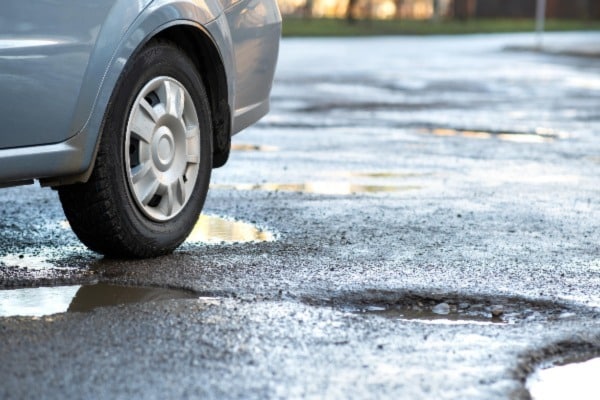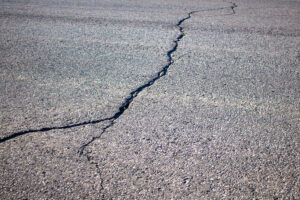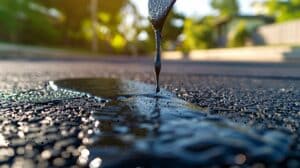Are you a facility manager or property owner noticing some deterioration in your parking lot? Many factors affect pavement structural issues, including weather, high traffic, and time. Knowing why these problems occur and when to sealcoat your parking lot is critical to parking lot maintenance.
Here are seven warning signs that your parking lot needs asphalt sealcoating before it becomes a more significant issue.
7 Signs Your Parking Lot Needs Sealcoating
If you own a parking lot, it’s essential to keep up with regular parking lot maintenance to prolong its lifespan. There are seven signs to look out for in your parking lot. If you notice any of these signs, it’s crucial to act right away and have your parking lot sealcoated by a professional parking lot repair company. Sealcoating helps protect the parking lot from further damage and extends its lifespan.
1. Deterioration
Asphalt is a durable material that can withstand a lot of wear and tear. However, over time, it will show signs of deterioration. Below are the four most common types of deterioration you should know about.
Cracks
The most common type of deterioration is cracking. Cracks are caused by various factors, including:
- Weather
- Poor drainage
- Excessive weight
Once a crack forms, water, and other materials enter the asphalt and cause further damage. If left unrepaired, cracks will spread, eventually leading to structural failure. Cracks should always be filled and sealcoated as soon as they are noticed to prevent further deterioration.
Potholes
Potholes are a common deterioration problem in parking lots, driveways, and roads. Over time, the constant flow of traffic can wear down the asphalt, causing it to crack and crumble. When water seeps into these cracks, it can cause the asphalt to expand and contract, weakening the pavement even further. Eventually, deterioration creates potholes.
To prevent potholes, it’s vital to perform regular parking lot maintenance, including asphalt repair and sealcoating. These preventive measures help extend the parking lot’s lifespan.
Edges
The term “edge” refers to the pavement’s interface with the unpaved shoulder and roadside.
Edges are necessary for asphalt for the following reasons:
- Supporting the driving surface
- Preventing water and debris from entering the road
- Providing safe recovery for errant vehicles
For these reasons, asphalt pavement edges must be well-defined and structurally sound.
Asphalt pavements have three types of edges: longitudinal, transverse, and sloped.
Longitudinal edges are created by the asphalt pavement’s interface with the curb or gutter — while transverse edges occur at joints between pavement sections.
Sloped edges occur when transitioning between a paved surface and an unpaved one. All three types of edges play an essential role in the overall structural integrity of asphalt pavement.
Sunken Areas
Sunken areas, or depressions, in asphalt, are typically caused by poor compaction of the subgrade, traffic loading, or both.
Traffic loading is the vehicle weight driving on the asphalt. The subgrade is the layer of soil underneath the asphalt, which needs to be appropriately compacted before the asphalt is laid down. If compacted correctly, the subgrade will settle over time, preventing the asphalt from sinking.
To avoid sunken areas in asphalt, it’s important to compact the subgrade properly and design the pavement thickness to withstand traffic loading. Regular parking lot maintenance and repairs can help prevent or delay deterioration while extending the life of your parking lot.
Unsure of your driveway or parking lot’s damage? Our asphalt experts can assess your pavement’s condition and recommend repairs or replacements.
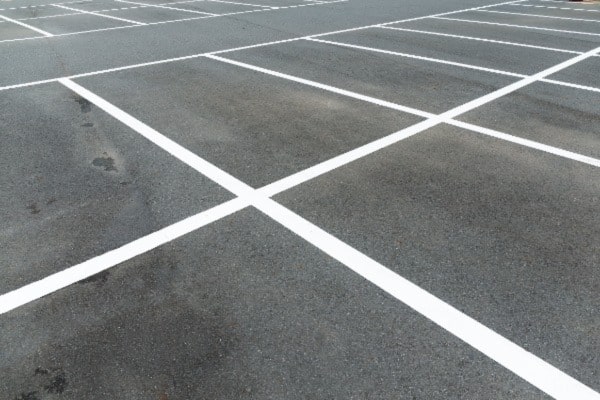
2. Color Fading
Over time, the sun’s ultraviolet (UV) rays break down the binding agents in asphalt, causing it to be brittle and allowing the color pigments to leach out. This breakdown process is accelerated by moisture, which can penetrate the asphalt and wash away the color pigments. Once the color pigments are gone, the asphalt will have a dull, gray appearance.
Parking lot sealcoating helps protect asphalt from UV damage and fading by creating a barrier between the asphalt and the sun’s rays. Additionally, sealcoating helps to prevent moisture from penetrating the asphalt, which helps preserve the color pigments.
3. Loose Raveling
Loose raveling is a common issue in asphalt parking lots. It occurs when the aggregate starts to pull away from the rest of the asphalt mix. This can happen for several reasons, but the most common is that the asphalt wasn’t correctly compacted when it was first laid down. Loose raveling is caused when the parking lot is laid during hot weather because the asphalt mix will soften and become difficult to compact.
Raveling can also happen if there are weak spots in the asphalt mix, such as voids or cracks. These weak spots can act as stress points that cause the aggregate to pull away from the rest of the asphalt. Once raveling starts, it can quickly lead to larger cracks and potholes forming in the parking lot.
4. Stains
Parking lots are one of the most common places to find stains. But how do these stains happen? This section will cover the most common stains you’ll likely find on your parking lot and how to remove them.
Oil Stains
Oil stains occur on parking lot asphalt for a variety of reasons. One common cause is leaks from vehicles. When a vehicle’s oil pan or engine oil line leaks, the oil can drip onto the asphalt and create a stain. Once an oil stain has formed, it can be difficult to remove. However, there are a few methods that can clean asphalt.
One approach is to cover the stain with cat litter or sand, allow it to absorb the oil, and then scrub it away with soapy water. Another is to treat the stain with a commercial degreaser and then pressure wash it away. With proper care, oil stains can be removed from parking lot asphalt.
Paint Stains
Paint stains on parking lots can occur in various ways, such as accidental spills to improper disposal of paint materials. These stains create marks on the parking lot and can lead to damage over time as the paint wears away at the asphalt.
When you notice a stain, it’s essential to address it quickly before it can set in and become more difficult to remove. Hot water pressure washing often eliminates fresh paint stains. Stronger chemical solutions may be necessary for older or more stubborn stains.
Drink Stains
Spilling drinks are common, especially in parking lots. Some beverages will evaporate or get washed away naturally by rain, but other drinks like coffee or some alcohol can stain the asphalt. Either way, it’s best practice to be proactive and wash away spills with a hose as soon as they’re noticed to prevent permanent stains.
Mulch Stains
When mulch is spread onto asphalt surfaces, the organic materials can cause stains when they encounter moisture. The moisture breaks down the organic materials and creates discoloration on the asphalt surface. Luckily, these stains are typically easily cleaned by pressure washing. Specialized cleaning products may be necessary for removing organic and stubborn stains.
Tire Tread Marks
Tire tread marks are a common issue on any asphalt surface. Since asphalt is designed to increase friction against tires for maximum contact, tires can leave behind marks from the rubber. These skid marks are easily cleaned with soapy water and a scrubber, but you must take care of them as soon as possible, or they will become more difficult to remove.
Remember that any stain on your parking lot asphalt can be cleaned relatively easily if it’s done before it can settle into the asphalt. If you wait too long or don’t catch a stain in time, it will permanently embed itself into the asphalt and become impossible to clean. The only solution for permanent stains is an asphalt overlay or a complete replacement.
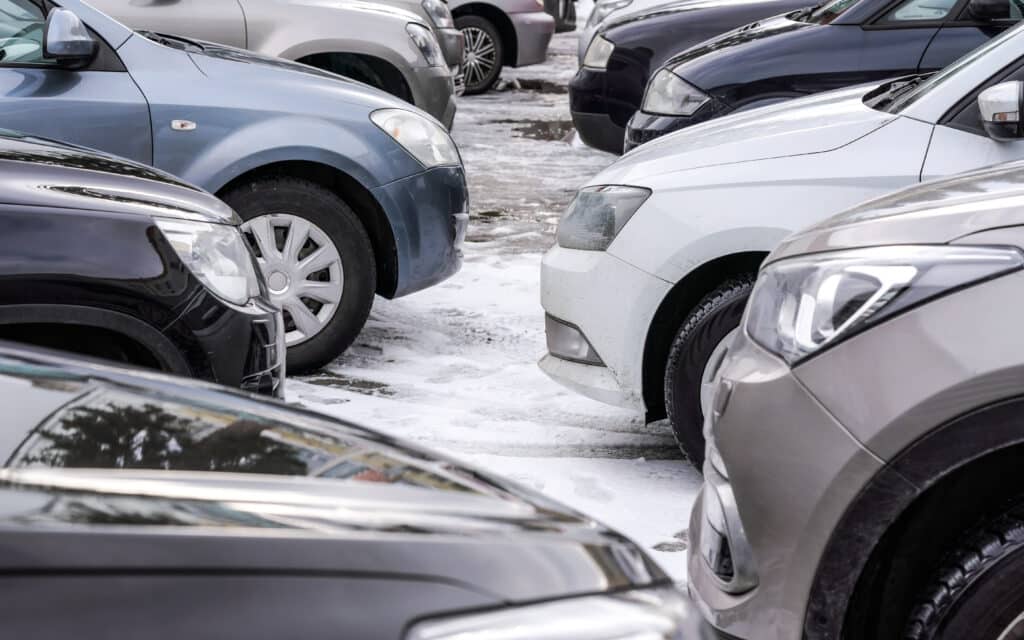
5. Winter Season is Approaching
The best time of year to sealcoat parking lots is in the late spring or early summer when the weather is warm and dry. In these conditions, the sealcoating will cure in approximately one to two days, depending on the formula used. Sealcoating can be done in colder and wetter weather, though it takes longer for the sealer to cure in these conditions. It takes roughly a week for sealcoating to cure in cold and rainy seasons.
The sealer must be applied evenly and smoothly, without any puddles or pooled areas. If a parking lot is sealcoated in cold weather, it’s essential to keep vehicles off it until the sealer can cure completely. Otherwise, the tires may stick to the sealer and cause damage.
Likewise, if a parking lot is sealcoated in rainy weather, it’s vital to allow plenty of time for the sealer to dry before allowing vehicles onto the surface. Temperature and weather conditions largely impact sealcoating and should be considered during routine parking lot maintenance.
6. Slow or Lack of Water Drainage
Slow or lack of water drainage can be a significant problem for asphalt parking lots, as standing water deteriorates the surface and leads to cracking and potholes. Standing water can also create a safety hazard, as it can make the parking lot slippery and challenging to drive and walk on.
It’s essential to have a parking lot maintenance company analyze the conditions, such as square footage, climate, and other environmental factors, when laying out the asphalt to allow for proper water drainage.
7. Three to Five Years Since the Last Sealcoating
If it’s been at least five years since your last parking lot sealing, it may be time for another coat. How long does asphalt sealcoating protect your pavement?
The answer depends on several factors, including:
- the type of sealant used
- asphalt condition
- weather condition severity
Sealcoating can last anywhere from three to five years. However, if you live in an area with harsh winters or intense summer heat, you may need to reapply sealant more frequently to keep your pavement in good condition.
Regular parking lot sealing allows your asphalt to last for decades. So, make scheduling your parking lot sealcoating at least every five years a priority to prolong its lifespan.
Sealcoat Your Parking Lot with Superior Asphalt
Preventative maintenance is key to preserving asphalt longevity. Now that you know the seven signs that indicate it might be time to sealcoat your parking lot, don’t wait until it’s too late!
Superior Asphalt is a reputable parking lot repair company specializing in commercial sealcoating. If you think it might be time to sealcoat or have any questions, our team is here to help. We specialize in parking lot maintenance services, including sealcoating, crack sealing, asphalt repairs, and paint striping.
Contact us for a free consultation or get a quote today!
Related Articles:

